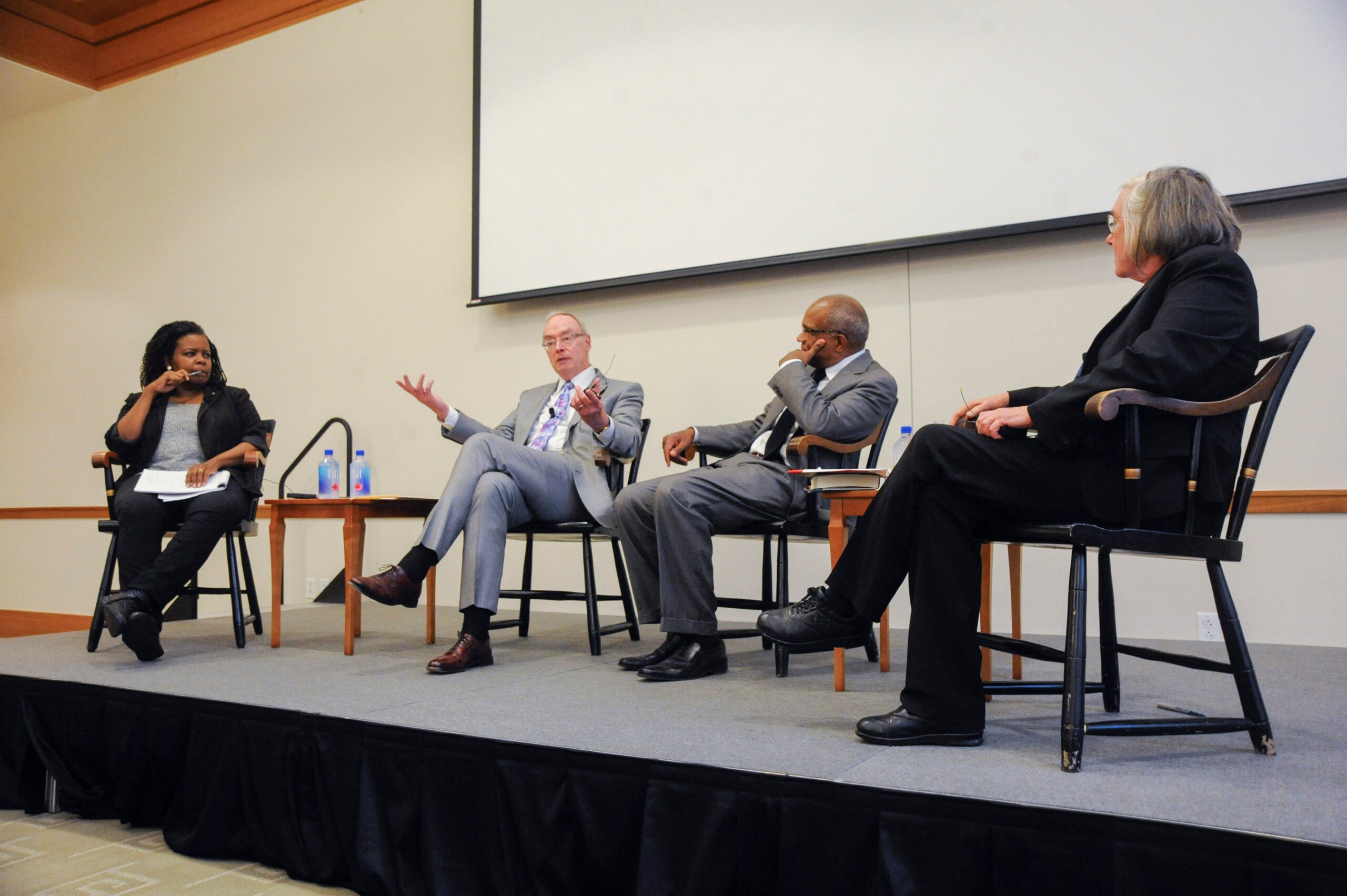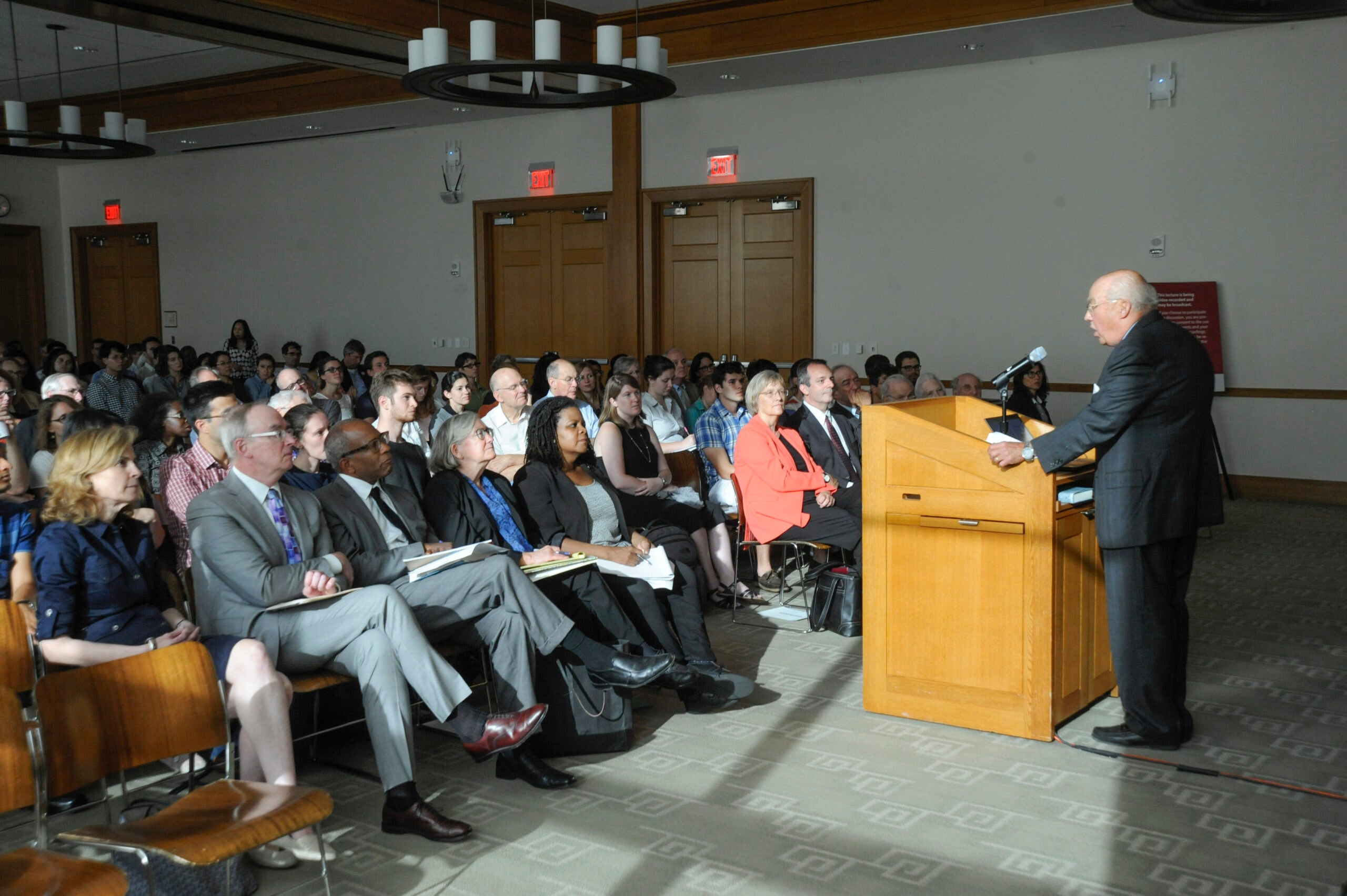To officially open Harvard Law School’s Bicentennial celebration, a panel of Harvard Law School faculty members gathered on Sept. 5 to discuss the law school’s early history, following a lecture by Visiting Professor Daniel R. Coquillette.
“As established as this school seems today, during its first 50 years it was a very high-risk venture that nearly failed, not once, but twice,” noted Coquillette. “And it was saved by people of great vision and genuinely radical ideas, ideas that were regarded as dangerous and completely new to conventional legal education.”
In an era when most students learned through apprenticeships, the Litchfield School of Law, established in Connecticut in 1784, was the first to provide practical training to a group of students—the model that was adopted when a bequest from Isaac Royall, Jr. endowed Harvard’s first chair in law in 1817. (Yale claims to have an earlier connection with the Litchfield School of Law, Coquillette quipped, but “under cross-examination” he has convinced them otherwise.)

By 1827, however, the law school was down to one professor and one student. Nathan Dane, a wealthy legal publisher, offered to build a new building and endow a chair for Joseph Story, a brilliant young Supreme Court Justice. Story’s vision—still in place today—was that HLS would be truly national and truly global; that every student would have an equal chance to demonstrate true merit; and that HLS would train not just practitioners but “the leaders of the common good.”
As the Civil War approached, Coquillette noted, HLS was “ripped … by controversies not that different, I’m afraid, from what we face today.” Story agonized over but then wrote the majority opinion for an 1842 Supreme Court ruling that a Pennsylvania law, meant to place restrictions on fugitive slave catchers, was unconstitutional. Many of the law school’s students and faculty members strongly supported the rights of slaveholders; others argued against its expansion into new states or territories, but only a small number were true abolitionists. “All hell broke loose” in 1854, when fugitive slave Anthony Burns was arrested in Boston. Rioting broke out, on the streets of Boston and in HLS classrooms, after magistrate Edward G. Loring, a member of the law school faculty, ruled that Burns should be returned to his owner under the Fugitive Slave Act.
HLS was second only to West Point in supplying military officers and government leaders to the Confederacy, and the casualty rate among HLS alumni, on both sides, was extraordinarily high. But Coquillette hinted that the appointment of Christopher Columbus Langdell as the law school’s new dean would once again turn things around, and that when barriers began to fall, an extraordinary group of new students would enter the law school’s battlefield of merit.
Four members of the faculty then offered their perspectives. When she received her chair in 2006, Professor Janet Halley recalled, she had no idea that the oldest one, the chair she was given, was “connected to the largest slaveholder possibly in all of Massachusetts.” As the Royall Professor, Halley has taken many students to visit the Royall House Museum and Slave Quarters in nearby Medford. The mansion, she noted, has been “preserved in very close to its original condition … but the interior of the slave quarters has been written over many times. So it’s almost emblematic of the access to memory that we have with respect to the two different parts of our founding family.”
Professor Randall Kennedy spoke about his admiration for Charles Sumner, an early HLS alumnus. Sumner was involved in an important challenge to the legality of racial segregation in Boston’s public schools; later, as a U.S. senator, he “was a tireless foe of oppression, including racial oppression, and … a tireless friend to the oppressed,” Kennedy noted. “No elected official in the 19th century, arguably in all of American history, was more consistent than Sumner in campaigning for racial justice in the United States. He was one of the greats of our tradition.”
Professor Bruce Mann recalled the controversy that erupted two years ago over the former law school shield, with its design based on the Royall family’s coat of arms. “When you encounter something like the early association of Harvard Law School with slavery, it reminds you that your eyes have to be open,” he said. As an academic community, and especially as a law school, “it’s incumbent on us … to come to terms with that history … in the hope of spurring ourselves to continue to bend the arc of history toward justice.”
Professor Annette Gordon-Reed ’84, also a historian, noted that these discussions about race and slavery fit “the moment we’re in now”—including the very recent debates about memorials. In her time as an HLS student, she noted, “our professors [definitely] taught us that we were supposed to go out and be leaders in the world. But it’s good to hear that this was there from the beginning.” Looking forward, “justice is a concept that can be difficult for people to ferret out … but it’s a work in progress. The Law School is a work in progress,” Gordon-Reed added. “It’s an amazing time, as a historian, to see how much people are looking to the past to try to figure out where we should go. ”
As the program ended, the audience joined Dean John Manning ’85, Harvard President Drew Gilpin Faust, and the faculty panel for the unveiling of the Law School’s memorial to the enslaved people whose labor helped make possible the founding of the school.
